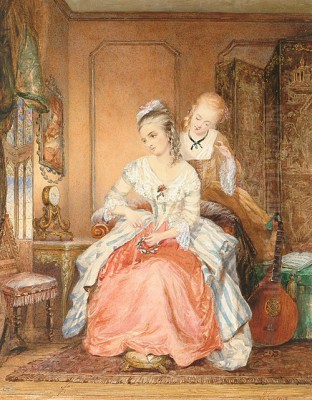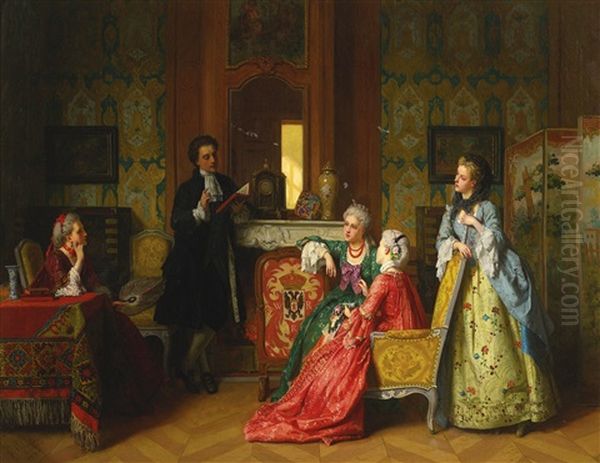
Jean Carolus stands as a notable figure in 19th-century European art, a Belgian painter who carved a distinct niche for himself primarily within the vibrant art scene of France. Born in Brussels in 1814 and passing away in France in 1897, Carolus dedicated his career to capturing the elegance, leisure, and refined aesthetics of a bygone era, particularly the French 18th century. He became renowned for his meticulously detailed and richly colored genre scenes, often set within opulent interiors or idyllic garden landscapes, populated by figures clad in luxurious historical costumes.
While rooted in the academic traditions of his time, Carolus developed a style characterized by its polished finish, narrative clarity, and nostalgic charm. His work appealed to a clientele appreciative of technical skill and evocative depictions of aristocratic life, offering a visual escape into the perceived grace and sophistication of the Ancien Régime. Though perhaps less revolutionary than some of his contemporaries, Jean Carolus remains significant for his mastery of historical genre painting and his contribution to the diverse tapestry of 19th-century art.
Early Life and Artistic Formation in Belgium
Jean Carolus was born in Brussels, the capital of Belgium, in 1814. This placed him within a nation newly independent (since 1830) and actively forging its own cultural identity, yet still deeply connected to the artistic currents of neighboring France. His early artistic training took place in his native city, a significant center for the arts with a rich history.
Crucially, Carolus studied under François Joseph Navez (1787–1869). Navez was a leading figure in Belgian Neoclassicism, himself a pupil of the great French Neoclassical master Jacques-Louis David. Navez served as the director of the Brussels Royal Academy of Fine Arts and was highly respected as both an artist, particularly for his portraits, and an educator. This training undoubtedly instilled in Carolus a strong foundation in drawing, composition, and the precise rendering of form, hallmarks of the Neoclassical tradition.

However, the artistic environment in Belgium during Carolus's formative years was not solely Neoclassical. Romanticism was also a powerful force, championed by figures like Gustave Wappers. This blend of influences – the discipline of Neoclassicism and the potential for historical narrative and richer palettes seen in Romanticism – likely shaped Carolus's developing artistic sensibilities before he sought broader horizons.
Relocation to France and Career Development
At some point, likely seeking greater opportunities and exposure within the dominant European art center of the time, Jean Carolus moved to France. He spent the majority of his working life there, immersing himself in the Parisian art world. Paris was the undisputed hub, home to the influential École des Beaux-Arts and the prestigious annual Salon, the primary venue for artists to exhibit their work and gain recognition.
Carolus established himself as a painter specializing in genre scenes, a category that encompassed depictions of everyday life, albeit often idealized or historical. His chosen focus on the 18th century, particularly scenes evoking the courts of Louis XV and Louis XVI, proved popular. This era, viewed through a nostalgic lens in the 19th century, represented a pinnacle of French elegance, fashion, and aristocratic leisure.
His meticulous technique and appealing subject matter found favor with collectors, both French and international. While not aligned with the emerging avant-garde movements like Realism or later Impressionism, Carolus operated successfully within the established academic system and the tastes of the bourgeois art market, which often preferred polished, narrative, and historically evocative works.
Artistic Style: Detail, Elegance, and Historical Evocation
The defining characteristics of Jean Carolus's art lie in his remarkable attention to detail, his elegant compositions, and his ability to convincingly evoke the atmosphere of the 18th century. His paintings are often jewel-like, inviting close inspection to appreciate the intricate rendering of fabrics, furniture, and architectural elements.
Carolus possessed a masterful ability to depict textures. Silks, satins, velvets, and lace are rendered with convincing realism, capturing the sheen, weight, and drape of luxurious materials. Similarly, he paid close attention to the details of interior decoration – gilded boiseries, ornate mirrors, marquetry furniture, and delicate porcelain are all painted with precision, contributing significantly to the historical authenticity and richness of the scene.

His color palette is typically bright, clear, and harmonious, avoiding the dramatic chiaroscuro favored by some Romantics or the broken brushwork of the later Impressionists. Instead, he employed smooth application and careful modeling to create polished surfaces and a sense of refined order. Figures are gracefully posed, often engaged in genteel activities like conversation, games, music, or courtship, reinforcing the overall impression of elegance and decorum.
This focus on high finish and meticulous detail aligns him broadly with other successful academic painters of the era, such as the French artists Jean-Léon Gérôme or Ernest Meissonier, although Carolus's subject matter remained consistently focused on the Rococo and late Bourbon periods, rather than the classical or military themes often favored by Gérôme and Meissonier respectively.
Themes of Leisure and Aristocracy
Jean Carolus consistently returned to themes centered around the leisured pursuits of the 18th-century aristocracy. His paintings often depict intimate gatherings in sumptuously decorated salons, gardens, or private chambers. These scenes capture moments of social interaction, entertainment, and quiet contemplation, presenting an idealized vision of life among the elite before the French Revolution.
Subjects such as card games, billiards, musical performances, reading sessions, tea parties, and romantic encounters feature prominently. These activities allowed Carolus to showcase elaborate costumes, elegant manners, and the luxurious settings associated with the period. His figures, while often idealized types rather than specific portraits, convey a sense of poise and sophistication appropriate to their station.
This thematic focus tapped into a 19th-century fascination with the Ancien Régime. For some viewers, these paintings offered a nostalgic escape from the rapid industrialization and social changes of their own time. For others, they represented a standard of taste and refinement. Carolus skillfully catered to this interest, becoming a specialist in recreating the visual splendor of the era of artists like Jean-Antoine Watteau, François Boucher, and Jean-Honoré Fragonard, albeit filtered through a 19th-century sensibility.
Representative Works
Several key works exemplify Jean Carolus's style and thematic concerns. Among his most famous is A Game of Billiards under Louis XV. This painting, now housed in the Ypres Museum (Stedelijk Museum, Ieper) in Belgium, perfectly encapsulates his approach. It depicts a group of elegantly dressed men and women gathered around a billiard table in a richly appointed room. The attention to detail in the costumes, the furniture, the wood paneling, and even the reflections on the polished surfaces is remarkable. The composition is balanced, the colors are vibrant, and the overall mood is one of refined leisure and social grace.
Another significant work is A Reading from Molière. This painting again places figures in historical costume within a detailed interior setting. The subject highlights cultural pursuits, suggesting intellectual refinement alongside social elegance. The careful rendering of the room's architecture and furnishings provides a convincing backdrop for the gathering, showcasing Carolus's skill in creating immersive historical environments.
His painting La chirurgie de maître Jean Ypermans, le père de la chirurgie flamande (1295–1351), dated 1854, indicates a potential exploration of earlier historical subjects, specifically related to Flemish history. While still a genre scene involving figures in a historical setting, its subject matter—depicting the "father of Flemish surgery"—differs from his more typical aristocratic themes, suggesting a broader range, perhaps undertaken earlier in his career or for a specific commission related to Belgian history.
Other works, such as The Artist's Studio and The Proposal of Marriage, also held by the Ypres Museum, further demonstrate his focus on interior scenes and narrative moments, rendered with his characteristic high finish and attention to period detail. These paintings solidify his reputation as a master of the historical genre interior.
Context within 19th-Century Art
Jean Carolus worked during a period of immense artistic change and diversification in Europe. While he established his career within the framework of the French academic system, which valued historical subjects and technical polish, other movements were challenging this dominance. Gustave Courbet had championed Realism, focusing on unidealized depictions of contemporary life and labor. Later in Carolus's career, Impressionism revolutionized painting with its focus on light, color, and capturing fleeting moments, executed with looser brushwork.
Carolus, however, largely remained committed to his chosen style and subject matter. His work can be seen alongside that of other Belgian artists who found success with genre painting, such as Alfred Stevens, who also worked in Paris and depicted elegant scenes of contemporary female life, albeit with a more modern sensibility than Carolus's historical focus. He can also be contextualized with Belgian historical painters like Henri Leys or Gustave Wappers, though Carolus generally favored more intimate, less grandiose scenes than the large historical canvases often produced by the latter two.
In France, his detailed historical genre scenes found a parallel in the work of artists like Ernest Meissonier, celebrated for his small-scale, minutely detailed historical and military paintings. While differing in subject, both artists appealed to collectors who valued virtuoso technique and historical narrative. Carolus's work also existed alongside the highly finished academic paintings of figures like William-Adolphe Bouguereau, though Bouguereau focused more on mythological or allegorical subjects.
Carolus's dedication to 18th-century themes places him within a broader 19th-century interest in historical revival styles, seen not only in painting but also in architecture and decorative arts. His work provided a visual link to the Rococo masters like Watteau, Boucher, and Fragonard, offering a polished, accessible interpretation of their world for a 19th-century audience.
Social Activities and Artistic Contributions
While specific records of Jean Carolus's direct involvement in major social movements or extensive teaching activities (unlike some contemporaries) are scarce, his primary contribution lay in his artistic output and its reflection of certain cultural values. His paintings, exhibited presumably at the Paris Salon and sold through dealers, contributed to the visual culture of the time and satisfied a market demand for elegant, historical genre scenes.
His connection to François Joseph Navez links him to the mainstream of Belgian art education early in his career. His subsequent success in France demonstrates the porous borders of the European art world and the draw of Paris as its center. The consistent quality and appeal of his work affirmed the enduring popularity of meticulously crafted paintings depicting idealized historical moments, even amidst the rise of more avant-garde styles.
His paintings served as more than mere decoration; they functioned as historical evocations, reinforcing notions of French cultural heritage and aristocratic refinement. By specializing in the 18th century, Carolus helped perpetuate a particular image of that era, focusing on its elegance and charm rather than its social tensions or political complexities. His contribution, therefore, is primarily as a skilled practitioner and popularizer of a specific type of historical genre painting.
Legacy and Reception
During his lifetime, Jean Carolus achieved considerable success and recognition within his chosen field. His works were acquired by collectors who appreciated his technical skill, the charm of his subjects, and the nostalgic allure of the 18th century. The presence of several of his key works in the Ypres Museum collection today attests to his standing, particularly in his native Belgium.
While art history often focuses on the innovators and revolutionaries who pushed artistic boundaries, artists like Jean Carolus played an important role in the broader art ecosystem of the 19th century. They represented the continuation of established traditions of craftsmanship and catered to prevailing tastes, achieving a high level of proficiency and popularity.
Today, Jean Carolus is remembered as a specialist in historical genre painting, particularly interiors set in 18th-century France. His work is valued for its meticulous detail, elegant compositions, and evocative portrayal of aristocratic life. He stands as a fine example of a Belgian artist who successfully navigated the competitive Parisian art world, creating a body of work characterized by its refinement, technical polish, and enduring nostalgic appeal. His paintings offer a window into both the 18th century he depicted and the 19th-century tastes that admired such depictions.